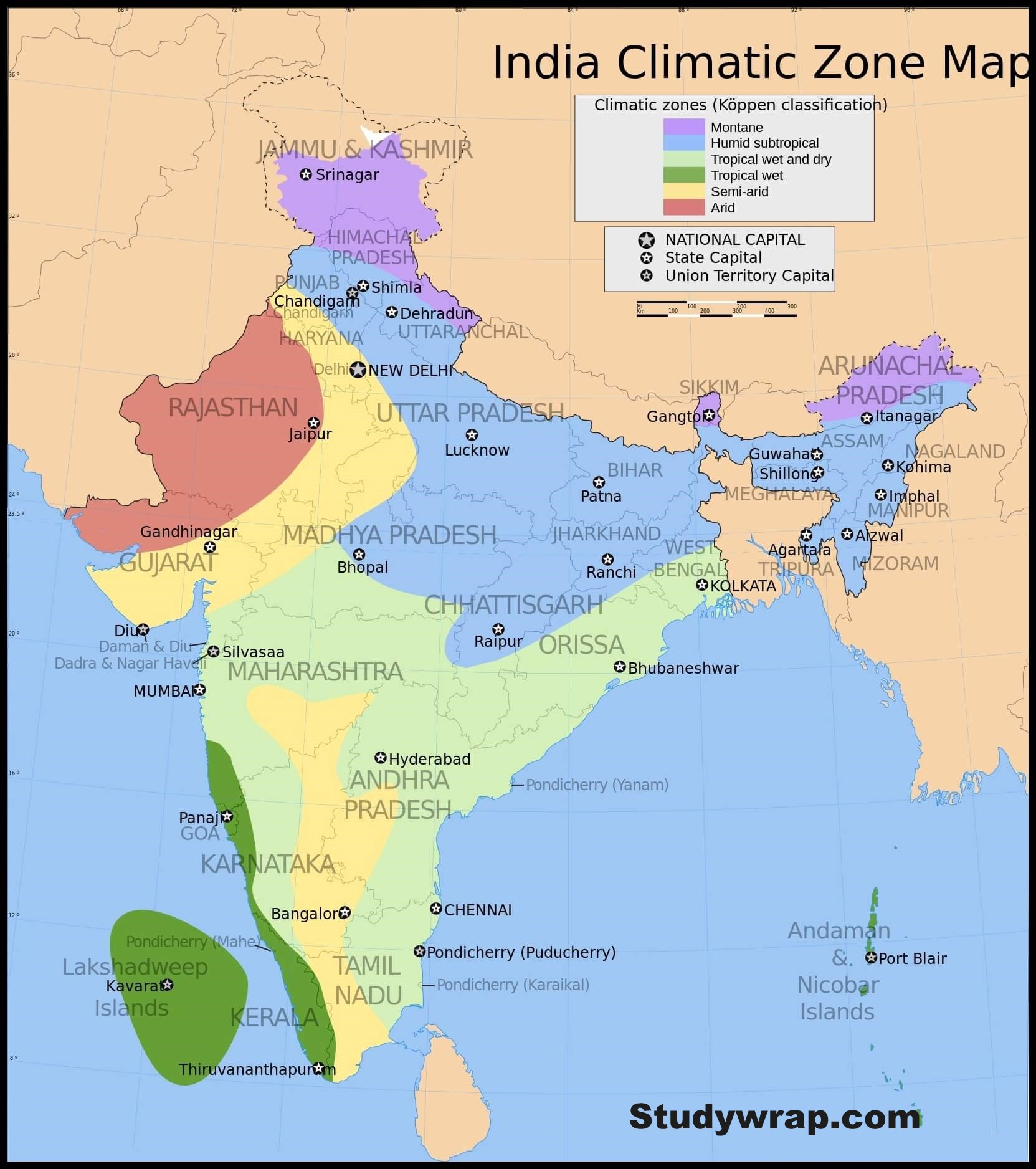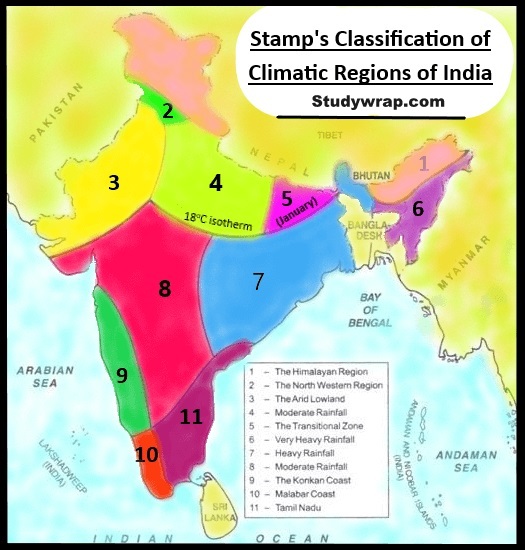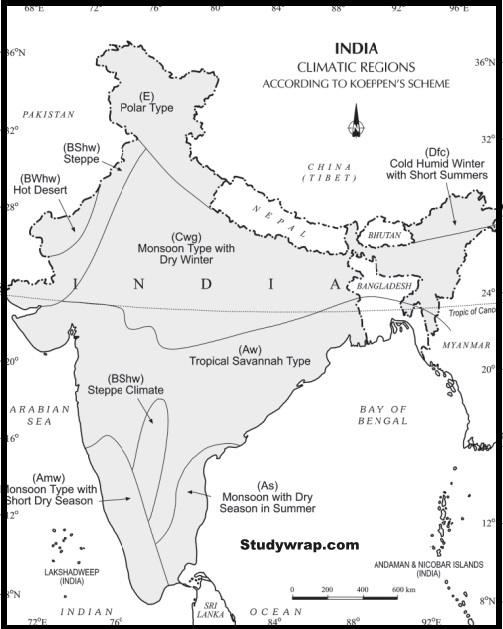The Indian Climate – Climatic Regions of India
Climatic Regions of India
- India has a monsoon type of climate with large regional variations in terms of rainfall and temperature. These variations represent the subtypes of the monsoon climate. It is on this basis that the climatic regions can be identified.
- A climatic region has a homogeneous climatic condition which is the result of a combination of factors. Temperature and rainfall are two important elements which are considered to be decisive in all the schemes of climatic classification.
- While classifying Indian climatic regions, most geographers have given more importance to rainfall than to temperature as variations in rainfall are much more marked than those of temperature.
Stamp’s Classification of Climatic Regions of India
-
- L. Dudley Stamp’s classification of Indian climate is much similar to that suggested by W.G. Kendrew.
- Stamp used 18°C isotherm of mean monthly temperature for January to divide the country into two broad climatic regions –
-
- Temperate or continental zone in the north and
- Tropical zone in the south.
-
- This line runs roughly across the root of the peninsula, more or less along or parallel to the Tropic of Cancer.
- The two major climatic regions are further divided into eleven regions depending upon the amount of rainfall and temperature.
1. Temperate or Continental India
Divided into five regions –
-
-
-
-
- The Himalayan region (heavy rainfall)
- The north-western region (moderate rainfall)
- The arid low land
- The region of moderate rainfall
- The transitional zone
-
-
-
2. Tropical India
Divided into six regions –
-
-
-
-
- Region of very heavy rainfall
- Region of heavy rainfall
- Region of moderate rainfall
- The Konkan Coast
- The Malabar Coast
- Tamil Nadu
-
-
-
|
Stamp’s Classification of Climatic Regions of India |
|||
|
A. Temperate or Continental India (Studywrap.com) |
|||
|
Region |
Avg Temperature |
Annual Rainfall |
|
|
Himalayan Region
|
Winter = 4°-7°C
Summer = 13°-18°C
|
East = Over 200 cm
West = much less than the east
|
|
|
North-western Region
|
Winter = 16°C
Summer = 24°C |
Below 200 cm
|
|
|
Arid Lowland
|
Winter = 16° to 24°C
Summer = 48°C |
Below 40 cm
|
|
|
Region of moderate rainfall
|
Winter = 15°-18°C
Summer = 33°-35°C |
40 – 80 cm
|
|
|
Transitional Zone |
Winter = 15°-19°C Summer = 30° – 35°C |
100 -150 cm
|
|
|
B. Tropical India (Studywrap.com) |
|||
|
Region of very heavy rainfall
|
Winter = 18°C Summer |
Over 200 cm
|
|
|
Region of heavy rainfall
|
Winter = 18°-24°C Summer = 29°-35°C |
100 – 200 cm
|
|
|
Region of moderate rainfall
|
Winter = 18°-24°C Summer = 32°C in |
50 -100 cm
|
|
|
Konkan Coast
|
Annual = 24°-27°C. (Remains fairly high with variation of 3oC only) |
Over 200 cm
|
|
|
Malabar Coast
|
Annual = 27°C (annual range of temperature is only 3oC) |
Over 250 cm
|
|
|
Tamil Nadu
|
Annual = 24°C (annual range of temperature is only 3oC) |
100 to 150 cm (Retreating monsoon)
|
|
Koppen’s Classification of Climatic Regions
-
- Dr. Wladimir Koppen in 1936 published his latest work where he presented a new scheme of Climatic Classification.
- Koeppen’s Classification of Climatic Regions of India is an empirical classification based on annual and monthly means of temperature and precipitation.
- Koppen accepts the native vegetation as the best expression of totality of a climate.
- Koppen has a view that the effectiveness of precipitation in vegetation growth depends not only upon the amount of precipitation, but also upon the intensity of transpiration and Evaporation.
- Koppen identified a close relationship between the distribution of vegetation and climate.
- He selected certain values of temperature and precipitation and related them to the distribution of vegetation and used these values for classifying the climates.
- Koppen recognized five major climatic groups, four of them are based on temperature and one on precipitation. He identified five major climatic types and used letter symbols A, B, C, D and E to denote them:
|
Climatic Groups According to Koppen (Studywrap.com) |
||
|
A |
Tropical Rainy climates (A) |
mean monthly temperature throughout the year is above 18°C |
|
B |
Dry climates (B) |
Where precipitation is very low in comparison to temperature.
|
|
C |
Warm temperate climates (C) |
Where mean temperature of the coldest month is between 18°C and minus 3°C. |
|
D |
Cool temperate climates |
Where mean temperature of the warmest month is over 10°C, and mean temperature of the coldest month is under minus 3°C. |
|
E |
Ice climates (E) |
Where mean temperature of the warmest month is under 10°C. |
-
- The above mentioned major climatic types are further subdivided into sub-types depending upon the seasonal distribution of rainfall or degree of dryness or cold. Koppen used small letters such as m, w or h to define these sub-types:
|
|
|
a |
hot summer, average temperature of the warmest month over 22°C |
|
c |
cool summer, average temperature of the warmest month under 22°C |
|
f |
no dry season |
|
w |
dry season in winter |
|
s |
dry season in summer |
|
g |
Ganges type of annual march of temperature; hottest month comes before the solstice and the summer rainy season. |
|
h |
(heiss) average annual temperature under 18°C |
|
m |
(Monsoon) short dry season. |
-
- The capital letters S and W are employed to designate the two subdivisions of dry climate:
-
- semi-arid or Steppe (S) and
- Arid or desert (W).
-
- Capital letters T and F are similarly used to designate the two subdivisions of polar climate
-
- tundra (T) and
- Icecap (F).
-
- The capital letters S and W are employed to designate the two subdivisions of dry climate:
-
- Koppen divided India into nine climatic regions making use of the above scheme.
|
Koeppen’s Scheme – Climatic Regions of India (studywrap.com) |
||
|
Climate type |
Region |
Annual rainfall |
|
Amw (Monsoon type with short dry winter season) |
|
over 300 cm |
|
As (Monsoon type with dry season in high sun |
|
75 – 100 cm |
|
Aw (Tropical Savanah type) |
|
75 cm
|
|
BShw (Semi-arid Steppe type) |
|
12 to 25 cm
|
|
BWhw (Hot desert type) |
|
less than 12 cm
|
|
Cwg (Monsoon type with dry winters) |
|
100 – 200 cm
|
|
Dfc (Cold, Humid winters type with shorter |
|
~200 cm
|
|
Et (Tundra Type) |
|
Rainfall varies from year to year. |
|
E (Polar Type) |
Higher areas of Jammu & Kashmir and Himachal Pradesh in which the temperature of the warmest month varies from 0° to 10°C |
Precipitation occurs in the form of snow |
So, with this the part, the topic of Climate of India in Indian Geography is complete.
From the next post (Click Here), we will start a new topic which is Natural Vegetation of India.




Pretty great post. I simply stumbled upon your weblog
and wished to mention that I’ve truly enjoyed browsing your blog posts.
After all I’ll be subscribing for your feed and I’m hoping you write once
more soon!
Amazing stuff. Keep it up!